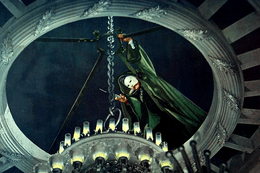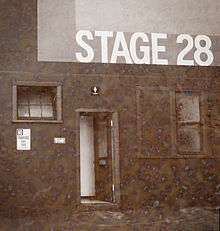Phantom of the Opera (1943 film)
Phantom of the Opera is a 1943 American horror film directed by Arthur Lubin, loosely based on Gaston Leroux's 1910 novel The Phantom of the Opera and its 1925 film adaptation starring Lon Chaney. Produced and distributed by Universal Pictures, the film stars Nelson Eddy, Susanna Foster and Claude Rains, and was filmed in Technicolor. The original music score was composed by Edward Ward.
| Phantom of the Opera | |
|---|---|
.jpg) Theatrical re-release poster | |
| Directed by | Arthur Lubin |
| Produced by | George Waggner |
| Screenplay by | |
| Story by | John Jacoby |
| Based on | The Phantom of the Opera by Gaston Leroux |
| Starring | |
| Music by | Edward Ward |
| Cinematography | |
| Edited by | Russell F. Schoengarth |
Production company | |
| Distributed by | Universal Pictures |
Release date |
|
Running time | 92 minutes |
| Country | United States |
| Language | English |
| Budget | $1.75 million[1] |
| Box office | |
The auditorium set, a replica of the Opéra Garnier interior, created for the previous iteration, was reused. Other than the sets, this remake had little in common with the earlier film. The original storyline was completely revised and there was no attempt to film the masked ball sequence, although the famous falling of the chandelier was re-enacted on an epic scale, using elaborate camera set-ups. It is also the only Universal horror film to win an Oscar, for Art Direction and Cinematography.
Plot

Violinist Erique Claudin is dismissed from the Paris Opera House after revealing that he is losing the use of the fingers of his left hand. Unbeknownst to the conductor, who assumes Claudin is able to support himself, the musician has used all his money to help anonymously fund voice lessons for Christine Dubois, a young soprano with whom he has fallen in love. In a desperate attempt to earn money, Claudin submits a piano concerto he has written for publication.
After weeks of not hearing a response about his concerto, he becomes worried and returns to the publisher, Maurice Pleyel, to ask about it. Pleyel rudely tells him to leave. Claudin hears his concerto being played in the office and is convinced that Pleyel is trying to steal it; unbeknownst to him, a visiting Franz Liszt had been playing and endorsing the concerto. Enraged, Claudin strangles Pleyel. Georgette, the publisher's assistant, throws etching acid in Claudin’s face, horribly scarring him. Now wanted for murder, Claudin flees into the sewers of the Opera, and covers his disfigurement with a prop mask.
Meanwhile, Inspector Raoul Dubert wants Christine to quit the Opera and marry him. But famed opera baritone Anatole Garron hopes to win Christine's heart. Christine considers them both good friends but doesn't openly express if she loves them.
During a performance of the opera Amore et Gloire, Claudin drugs a glass of wine which prima donna Mme. Biancarolli drinks, knocking her unconscious. The director puts Christine in her place and she dazzles the audience with her singing. Biancarolli, who suspects that Garron and Christine are responsible for drugging her, orders Raoul to arrest them, but he says he cannot because there is no evidence. Biancarolli says she will forget the whole affair only if Christine's performance is not mentioned in the papers. The following night, Claudin kills Biancarolli and her maid, and the opera is subsequently closed.
After some time, the opera's owners receive a note demanding that Christine replace Biancarolli. To catch Claudin, Raoul comes up with a plan: not let Christine sing during a performance of the (fictional) Russian opera Le prince masqué du Caucase (“The Masked Prince of the Caucasus”) so as to lure Claudin out into the open. Garron plans to have Liszt play Claudin’s concerto after the performance, but Claudin strangles one of Raoul's men and heads to the domed ceiling of the auditorium. He then brings down the large chandelier on the audience, causing chaos. As the audience and the crew flee, Claudin takes Christine down underground. He tells Christine that he loves her and that she will now sing all she wants, but only for him.
Raoul, Anatole and the police begin pursuing them underground. Just as Claudin and Christine arrive in his lair they hear Liszt and the orchestra playing Claudin's concerto. Claudin plays along with it on his piano. Christine watches, realizing the concerto was written around the melody of a lullaby she has known since childhood. Raoul and Anatole hear Claudin playing and follow the sound. Overjoyed, Claudin urges Christine to sing, which she does. While Claudin is distracted by the music, Christine sneaks up and pulls off his mask, revealing his disfigured face. At that same moment, Raoul and Anatole break in. Claudin grabs a sword to fight them with. Raoul fires his gun at Claudin, but Anatole knocks Raoul's arm and the shot hits the ceiling, causing a cave in. Anatole and Raoul escape with Christine, but Claudin is crushed to death by the falling rocks.
Later, Anatole and Raoul demand that Christine choose one of them. She surprises them by choosing to marry neither one of them, instead pursuing her singing career, inspired by Claudin’s devotion to her future. The film ends with Anatole and Raoul going to dinner together.
Cast
_trailer_1.jpg)
- Claude Rains as Erique Claudin/The Phantom Of The Opera. A violinist of the Opera House who becomes The Phantom. Secretly devoted to Christine.
- Nelson Eddy as Anatole Garron. A baritone of the Opera who loves Christine and helps her with her career.
- Susanna Foster as Christine DuBois. A soprano of the Opera House. She is unaware that Erique Claudin loves her and was the one who funded all her singing lessons.
- Edgar Barrier as Raoul Dubert. A policeman who wants Christine to quit the Opera and marry him.
- Jane Farrar as Biancarolli. An arrogant, spoiled diva who dislikes being upstaged.
- J. Edward Bromberg as Amiot
- Fritz Feld as Lecours
- Frank Puglia as Villeneuve
- Fritz Leiber as Franz Liszt
- Steven Geray as Vercheres
- Miles Mander as Maurice Pleyel
- Hans Herbert as Marcel
- Hume Cronyn as Gerard
- Hank Mann as Stagehand (uncredited)
Development
Universal first announced a remake of The Phantom of the Opera in 1935. This version would have been set in contemporary Paris, and would have portrayed the Phantom as a psychologically wounded World War I veteran who was physically unharmed, but imagined that he was disfigured. The screenplay lingered in development until 1941, when Henry Koster was brought on board to direct. Koster discarded the previous screenplay, and envisioned a new version of the story in which the Phantom was Christine's father. Producer George Waggner ultimately fired Koster from the project and replaced him with Arthur Lubin.[4]
Production
Cesar Romero, Boris Karloff, Feodor Chaliapin, Charles Laughton and Broderick Crawford were all considered for the role of the Phantom at various points during production, before the role was given to Rains.[4] Koster's subplot about the Phantom being Christine's father was jettisoned because it gave the romantic elements of their relationship incestuous overtones.[5] During the same year that the film was released, Phantom of the Opera was adapted into an audio presentation for the Lux Radio Theater. Nelson Eddy, Susanna Foster and Edgar Barrier reprised their roles, but instead of Claude Rains, Basil Rathbone played Erique Claudin. This presentation was produced and hosted by Cecil B. DeMille.
Score

Edward Ward wrote the score. The film has many elements of a musical, with lengthy opera sequences, and has been criticized for being more musical than horrific. For the opera sequences, Ward adapted music from Tchaikovsky's Symphony No. 4 as well as using themes by Chopin. He also composed an original theme, Lullaby of the Bells, which was heard in the film as the Phantom's piano concerto.
Reception
Contemporary reviews were mixed. Bosley Crowther of The New York Times panned the film for being "watered down" from the original, calling the opening sequence "the only one in the film in which the potential excitement of the story is realized," while otherwise the "richness of décor and music is precisely what gets in the way of the tale."[6] Variety called it "a vivid, elaborate, and, within its original story limitations, an effective production geared for substantial grosses."[7] Harrison's Reports called it "a good entertainment, the sort that will direct an appeal to all types of audiences."[8] David Lardner's review in The New Yorker dismissed the film, calling it "by no means a sample of the march of progress in the film world. The old version had Lon Chaney, who scared you plenty, and the new one has Claude Rains, who somehow doesn't."[9]
Rotten Tomatoes gave this version of Phantom of the Opera an average score of 75%, based on 20 reviews from critics.[10]
Diabolique magazine said "the story was reconfigured as a musical more than a horror saga... Once you accept that, this works well on its own terms and Lubin’s touch is assured; it looks splendid." [11]
Cancelled sequel
Following the success of Phantom of the Opera, Universal announced that a sequel would be made, titled The Climax.[5] Nelson Eddy and Susanna Foster were to return, along with Claude Rains as the Phantom, most likely meaning that his character survived the cave-in at the finale of the first film. The sequel, however, was later cancelled due to story troubles and problems concerning the availability of Claude Rains. The Climax was indeed released the year after Phantom of the Opera, but it was not a continuation of the previous film and featured completely new characters.
Awards
The film was nominated for four Oscars, winning in two categories:[12]
- Art Direction (Color) (John B. Goodman, Alexander Golitzen, Russell A. Gausman and Ira S. Webb) (Won)
- Cinematography (Color) (Hal Mohr and W. Howard Greene) (Won)
- Music (Scoring of a Musical Picture) (Edward Ward) (Nominated)
- Sound Recording (Bernard B. Brown) (Nominated)
References
- Michael Brunas, John Brunas & Tom Weaver, Universal Horrors: The Studios Classic Films, 1931-46, McFarland, 1990 p361
- "Top Grossers of the Season", Variety, 5 January 1944 p 54
- French box office in 1945 at Box office story
- "The Opera Ghost: A Phantom Unmasked". [Special Feature on DVD release of Phantom of the Opera]. Universal Studios, 2000.
- Scott McQueen, audio-commentary on Phantom of the Opera DVD (Universal)
- Crowther, Bosley (October 15, 1943). "Movie Review - Phantom of the Opera". The New York Times. Retrieved February 21, 2016.
- "Film Reviews". Variety. New York: Variety, Inc.: 10 August 18, 1943.
- "'The Phantom of the Opera' with Nelson Eddy, Claude Rains and Susanna Foster". Harrison's Reports: 136. August 21, 1943.
- Lardner, David (October 16, 1943). "The Current Cinema". The New Yorker. New York: F-R Publishing Corp.: 53.
- Rotten Tomatoes: Phantom of the Opera (1943)
- Vagg, Stephen (14 September 2019). "The Cinema of Arthur Lubin". Diabolique Magazine.
- "The 16th Academy Awards (1944) Nominees and Winners". oscars.org. Retrieved 2011-08-14.
External links
| Wikimedia Commons has media related to Phantom of the Opera (1943 film). |

- Phantom of the Opera on IMDb

- Phantom of the Opera at AllMovie

- Phantom of the Opera at the TCM Movie Database

- Phantom of the Opera at the American Film Institute Catalog

- Phantom of the Opera at Box Office Mojo

- Phantom of the Opera on Lux Radio Theater: September 13, 1943